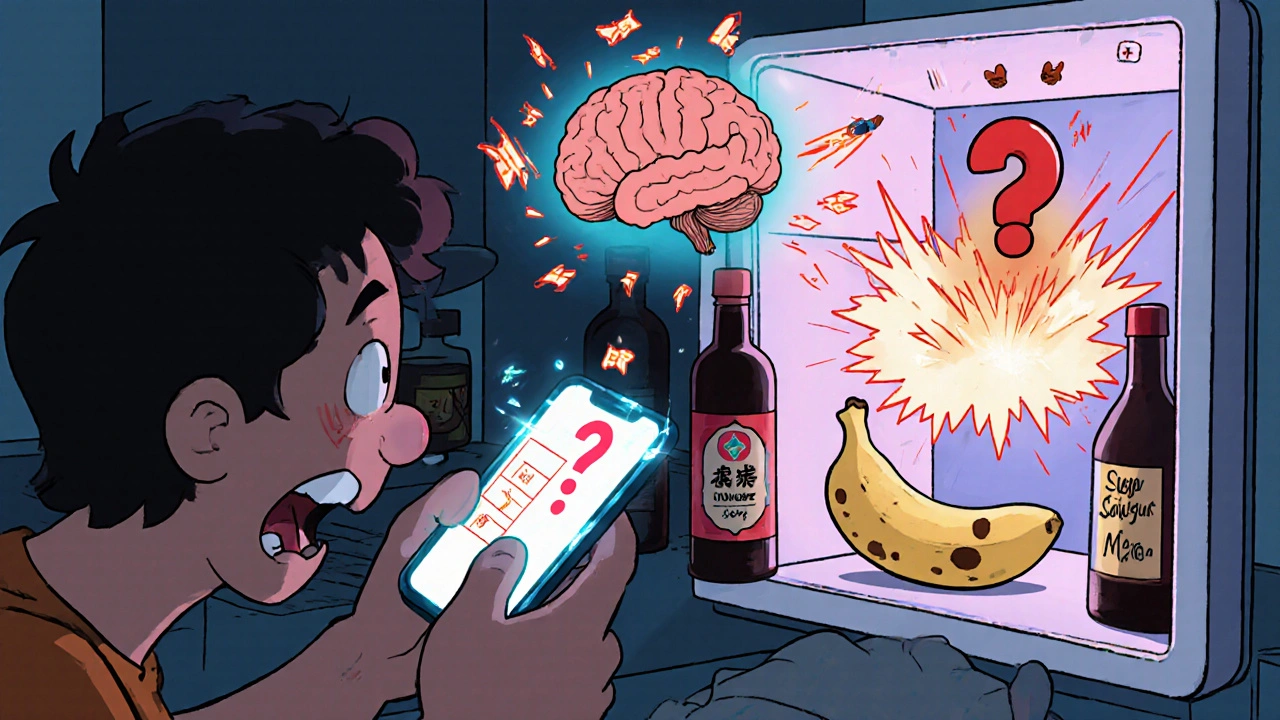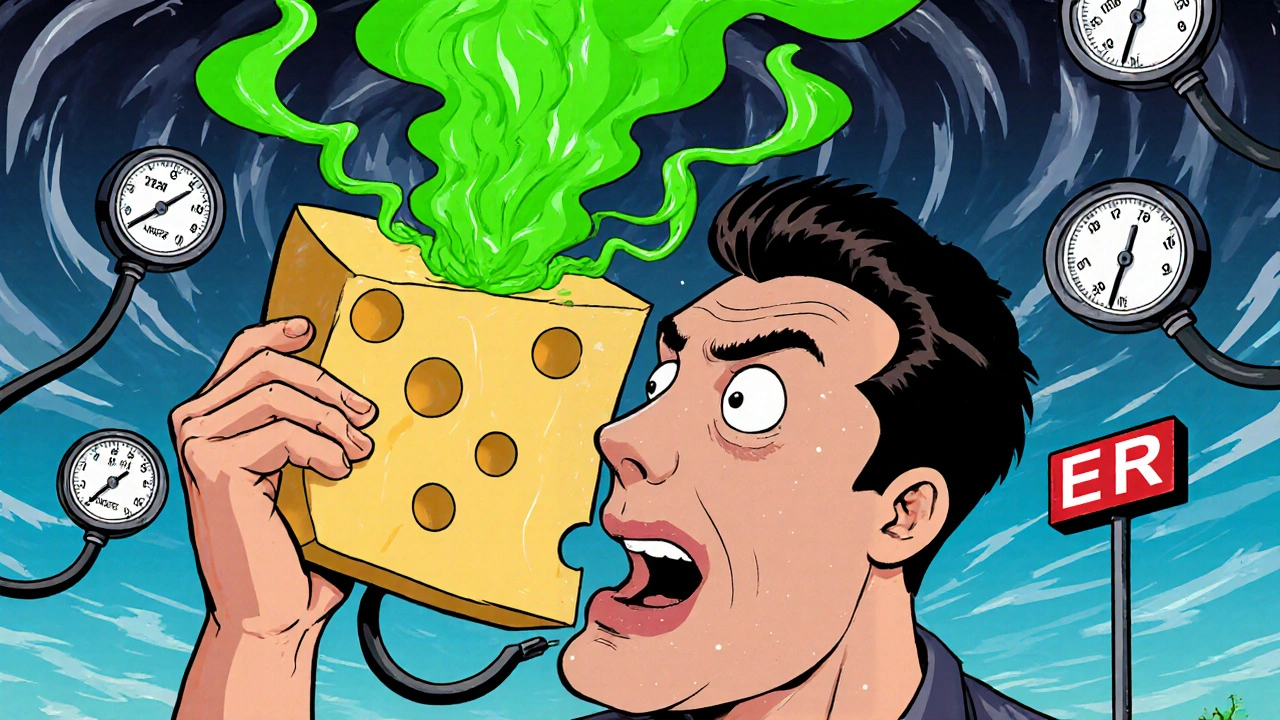Tyramine Risk Calculator
Assess Your Food Risk
Calculate tyramine content from your meal to determine safety while taking MAOI antidepressants. Total tyramine should stay below 6 mg for safety.
Cheeses
Processed Meats
When you're taking an MAOI antidepressant like Nardil or Parnate, your favorite sharp cheddar or pepperoni pizza isn't just a snack-it could be a medical emergency. This isn't scare tactics. It's science. Every year, hundreds of people on these medications end up in the ER because they didn't realize how dangerous a bite of aged cheese or slice of salami can be. The culprit? Tyramine-a compound naturally formed during aging and fermentation. And when your body can't break it down because of your medication, your blood pressure can spike dangerously fast.
What Is Tyramine and Why Does It Matter?
Tyramine isn't a chemical added to food. It's a byproduct of protein breakdown during aging, curing, or fermentation. The name even comes from the Greek word for cheese, tyros. It's found in high amounts in foods that sit around for weeks or months-like aged cheeses, dry-cured meats, and fermented sauces. For most people, the body breaks down tyramine using an enzyme called monoamine oxidase. But if you're on an MAOI (monoamine oxidase inhibitor), that enzyme is blocked. Tyramine builds up in your bloodstream and triggers a flood of norepinephrine-the same chemical your body releases during stress. The result? A sudden, severe spike in blood pressure.That spike isn't mild. It can hit 180/120 mmHg or higher within minutes. Symptoms include a pounding headache (often at the back of the head), chest pain, rapid heartbeat, sweating, blurred vision, and nausea. In worst-case scenarios, it leads to stroke, heart attack, or death. This interaction was first proven in 1965, and it's still causing emergencies today.
Which Cheeses Are Safe? Which Are Not?
Not all cheeses are created equal when it comes to tyramine. The difference between safe and dangerous comes down to how long it’s aged and how it’s made.- High-risk cheeses (avoid completely): Aged cheddar (72-953 mcg/g), Parmesan (610-1,400 mcg/g), Swiss (400-1,200 mcg/g), blue cheeses like Gorgonzola and Stilton (1,000-3,500 mcg/g), and brined feta (350-800 mcg/g). A single 30g serving of aged cheddar can contain over 25 mg of tyramine-enough to trigger a crisis in sensitive individuals.
- Moderate-risk cheeses (use extreme caution): Camembert, Brie (200-600 mcg/g), Gruyère, and Edam (150-500 mcg/g). Even small amounts can be risky depending on your personal sensitivity.
- Safe cheeses (generally okay): Fresh mozzarella (under 25 mcg/g), ricotta (under 40 mcg/g), cottage cheese (under 30 mcg/g), cream cheese (under 20 mcg/g), and American cheese (under 50 mcg/g). These are made from pasteurized milk and aren’t aged long enough for tyramine to build up.
Some brands now make “MAOI-safe” cheeses. Sargento, for example, sells refrigerated fresh mozzarella cups labeled for people on these medications. These products contain less than 20 mcg/g of tyramine and are a practical solution for those who want to enjoy cheese without risk.
Processed Meats: The Hidden Danger
If you think cheese is the only problem, think again. Processed meats are just as risky-and often more confusing.- High-risk meats: Dry-cured sausages like salami (150-500 mcg/g), pepperoni (200-600 mcg/g), and summer sausage (300-900 mcg/g). These are fermented and air-dried, which means tyramine builds up over time.
- Moderate-risk meats: Bacon (75-250 mcg/g), corned beef (60-180 mcg/g), and smoked ham (50-200 mcg/g). These aren’t as bad as salami, but they’re not safe either.
- Safe meats: Freshly cooked chicken, turkey, beef, or pork. If it’s not cured, smoked, or aged, it’s low-risk. Even deli turkey sliced fresh off the counter is usually fine.
Here’s the catch: labels don’t always tell you if a meat is dry-cured. “Nitrate-free” or “no preservatives added” doesn’t mean low tyramine. The curing process itself-whether using salt, smoke, or air-drying-is what creates the risk. When in doubt, avoid anything that looks like it’s been hanging in a deli case for weeks.

Other High-Risk Foods You Might Not Expect
Cheese and meat aren’t the only culprits. Many common foods contain hidden tyramine:- Soy sauce: 1,000-2,500 mcg/g
- Miso paste: 800-2,000 mcg/g
- Fish sauce: 1,200-3,000 mcg/g
- Tap beer and red wine: Can contain 100-500 mcg/g, depending on fermentation
- Overripe bananas: Over 10 mcg/g (ripe is fine; brown-spotted is risky)
- Peanuts and chocolate: Both have low levels (75-200 mcg/g and 50-150 mcg/g respectively) and are generally safe in normal amounts.
It’s not just about the food-it’s about how it’s stored. Leftovers sitting in the fridge for days can develop more tyramine. Always eat food fresh, and never reheat or consume anything past its prime.
How Much Is Too Much?
There’s no universal number that triggers a crisis. Some people react to as little as 6 mg of tyramine. Others can tolerate up to 25 mg before symptoms appear. That’s why blanket rules don’t always work.The NSW Agency for Clinical Innovation says 6 mg per serving is generally safe. But that’s an average. One person might feel fine eating 15g of aged cheddar. Another might have a severe reaction to 10g. That’s why tracking your own body’s response is critical.
Many patients keep a food and blood pressure diary. They record everything they eat and check their blood pressure before and after meals. This helps them find their personal threshold. One Reddit user, for example, found that 15g of aged cheddar (about 1-2 mg tyramine) was his limit. Anything more caused headaches and palpitations.
What Happens After You Stop Taking MAOIs?
You can’t just stop the medication and go back to eating cheese the next day. The enzyme that breaks down tyramine-monoamine oxidase-takes 14 to 21 days to fully recover after you stop taking the drug. That means you need to keep avoiding high-tyramine foods for at least two to three weeks after your last dose. Skipping this step is a common reason people end up in the ER even after they think they’re “off” the medication.
Practical Tips for Living With MAOIs
Managing this diet isn’t easy, but it’s doable. Here’s how:- Read labels carefully. Look for words like “aged,” “cured,” “fermented,” “dry-cured,” or “air-dried.” Avoid anything with a long shelf life.
- Choose fresh over packaged. Buy meat sliced fresh at the counter. Pick cheeses from the refrigerated section that say “fresh” or “unaged.”
- Use apps. The Mayo Clinic’s “MAOI Diet Tracker” app scans barcodes and flags high-tyramine foods with 89% accuracy.
- Carry an emergency card. It should list your medication, the dietary restriction, and symptoms of a hypertensive crisis. This helps first responders act fast.
- Monitor your blood pressure. Check it twice a day. If your systolic number jumps more than 30 points after eating, stop and call your doctor.
- Ask for help. A registered dietitian who specializes in medication interactions can cut your learning curve from 6 weeks to 2-3.
Why Do So Many People Still Get It Wrong?
Despite decades of warnings, dietary non-compliance is the #1 reason for MAOI-related ER visits. A CDC report from 2022 found that 61% of these emergencies happen because people didn’t follow the diet. Why?- Restaurants rarely label tyramine content.
- People think “a little won’t hurt.”
- They don’t realize that “fresh” cheese in the deli might actually be aged.
- Social pressure-no one wants to be the person asking for a cheese-free salad at a dinner party.
But the stakes are too high to gamble. One user on Drugs.com described eating a Parmesan salad while on Nardil and ending up with a blood pressure of 198/112. “The headache was like nothing I’ve ever experienced,” they wrote. That’s not an exaggeration.
What’s Changing in the Future?
There’s hope on the horizon. Researchers are testing a supplement that helps break down tyramine before it enters the bloodstream. If it works, it could remove the need for strict diets entirely. The NIH is funding a clinical trial for this, with results expected in late 2024.Food companies are also stepping up. The EU now requires tyramine levels to be listed on aged cheese packaging. In the U.S., the American Pharmacists Association is pushing for voluntary labeling by 2025. And scientists are even exploring genetically modified cheeses with naturally lower tyramine levels.
But until those solutions are widely available, the rule remains simple: if it’s aged, cured, or fermented, avoid it. Your life depends on it.
Can I eat blue cheese if I’m on an MAOI?
No. Blue cheeses like Gorgonzola, Stilton, and Roquefort contain 1,000-3,500 mcg of tyramine per gram. A single 30g serving can deliver over 100 mg of tyramine-far above the dangerous threshold. Even a small bite can trigger a life-threatening blood pressure spike. Avoid all blue cheeses completely while on MAOIs.
Is mozzarella safe on MAOIs?
Yes, if it’s fresh mozzarella made from pasteurized milk and stored refrigerated. Fresh mozzarella contains less than 25 mcg/g of tyramine. Avoid aged or smoked mozzarella, and never eat mozzarella that’s been sitting out or in the deli case for days. Stick to sealed, refrigerated packages labeled “fresh.”
How long do I need to avoid these foods after stopping MAOIs?
You must continue avoiding high-tyramine foods for at least two to three weeks after your last dose. The enzyme that breaks down tyramine takes 14-21 days to fully recover. Stopping the medication doesn’t mean the risk disappears overnight. Rushing back to aged cheese or salami during this time can still cause a hypertensive crisis.
Can I drink wine or beer on MAOIs?
Most alcoholic beverages carry some risk. Tap beer and red wine can contain 100-500 mcg/g of tyramine due to fermentation. Even small amounts can trigger reactions in sensitive individuals. The safest approach is to avoid alcohol entirely while on MAOIs. If you choose to drink, limit it to one small glass of white wine and monitor your blood pressure closely.
What should I do if I accidentally eat high-tyramine food?
If you’ve eaten aged cheese, salami, or another high-tyramine food, check your blood pressure immediately. If your systolic pressure is above 180 or you have symptoms like severe headache, chest pain, or blurred vision, call 911 or go to the ER. Don’t wait. Tyramine-induced crises can escalate within minutes. If you’re unsure, contact your doctor or poison control center right away.







gent wood
November 15, 2025 AT 00:03This is one of those posts that saves lives. I'm on Nardil and I used to think aged cheese was just 'strong'-turns out it was almost killing me. My BP spiked to 190/115 after a slice of cheddar at a friend's BBQ. I didn't even know what hit me. Now I carry an emergency card in my wallet. If you're on MAOIs, read this twice. And share it.
Dilip Patel
November 16, 2025 AT 13:28lol u guys are so paranoid. In India we eat aged paneer with chilli and no one dies. MAOIs are just western overmedication. My uncle took antidepressants for 20 years and he eats parmesan like its samosa. You people need to chill. Its not 1965 anymore.
Jane Johnson
November 18, 2025 AT 02:17While I appreciate the clinical detail, I must note that the assumption that all individuals will comply with such a restrictive diet is fundamentally flawed. The psychological burden of dietary vigilance is rarely addressed in medical literature, and the social isolation it induces is often more detrimental than the physical risk itself.
Peter Aultman
November 18, 2025 AT 09:22Just started on Parnate last month and this post is a lifesaver. I used to love pepperoni pizza. Now I make my own with fresh mozzarella and no cured meats. Tastes different but I'm alive. Also bought that Mayo app-it flagged my favorite soy sauce. Who knew?
Sean Hwang
November 18, 2025 AT 09:49fresh mozzarella from the deli counter is fine if its in the fridge and not sitting out. I work at a grocery and we label the ones that are safe for MAOI folks. Just ask the cheese guy. They know. Also avoid tap beer. Bottled is usually okay if its not dark or sour.
Barry Sanders
November 20, 2025 AT 04:57Typical. Another post that scares people into compliance. You're not a lab rat. If you can tolerate a glass of wine, you can handle a bite of cheese. The real danger is anxiety, not tyramine. Stop treating your diet like a nuclear protocol.
Chris Ashley
November 20, 2025 AT 19:45bro i ate blue cheese last week and i'm fine. maybe ur just weak. i took my med at 8am and had gorgonzola at 7pm. no headache. no chest pain. just a good snack. stop being dramatic.
kshitij pandey
November 21, 2025 AT 01:51As someone from India who’s been on MAOIs for 5 years, I want to say this: you're not alone. My mom made me fresh paneer every day, and I avoided fermented sauces. It’s hard, but possible. Share this with your friends. We need more awareness, not fear. You got this.
Brittany C
November 22, 2025 AT 14:57The pharmacokinetics of tyramine metabolism in the context of irreversible MAO-A inhibition are well-documented in the Journal of Clinical Psychopharmacology, 2021. The threshold for hypertensive crisis varies by genetic polymorphism in the MAO-A gene, particularly rs6323. Dietary tyramine exposure should be quantified in mg/kg, not by food type alone.
Sean Evans
November 23, 2025 AT 00:12YOU PEOPLE ARE DEADLY. 😡 I read this and I’m shaking. You’re not just risking your life-you’re risking everyone’s. One person has a crisis, ER gets slammed, nurses get burned out. Stop being selfish. If you can’t follow this, don’t take the med. That’s the real answer. 💀
Anjan Patel
November 24, 2025 AT 05:47My cousin took MAOIs and ate salami. He ended up in ICU for 11 days. His wife cried for a week. Now he can't even taste food without panic. This isn't diet. This is survival. And if you think you're immune? You're not. You're just lucky. So far.
Scarlett Walker
November 24, 2025 AT 15:27I used to think I couldn’t enjoy life on MAOIs. Then I found the Sargento fresh mozzarella cups. I put them on crackers with tomato and basil. Tastes like heaven. No panic. No BP spike. Just simple joy. You don’t have to give up everything. Just the scary stuff.
Hrudananda Rath
November 26, 2025 AT 10:35It is with profound regret that I must observe the lamentable state of contemporary dietary compliance among the pharmacologically compromised. The casual dismissal of tyramine risk reflects not merely ignorance, but a disturbing erosion of the sacred covenant between physician and patient. One must ask: when did caution become a form of oppression?